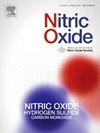一氧化碳是代谢相关性脂肪肝进展过程中 HIF-1α 的负反馈机制。
IF 3.2
2区 生物学
Q2 BIOCHEMISTRY & MOLECULAR BIOLOGY
引用次数: 0
摘要
代谢相关性脂肪肝(MAFLD)包括多种慢性肝病,但目前尚无获批药物。缺氧诱导因子-1α(HIF-1α)在代谢相关性脂肪肝的发展中起着关键作用。我们之前的研究强调了纳米设计的一氧化碳(CO)供体在小鼠肝脂肪变性模型中针对 HIF-1α 的疗效。鉴于血红素加氧酶-1(HO-1,HIF-1α的一个主要下游分子)是内在一氧化碳的主要来源,我们推测HO-1/CO的上调会对HIF-1α做出反应,从而形成一个调节MAFLD进展的负反馈环路。在本研究中,我们探讨了 CO 对 HIF-1α 的潜在负反馈机制及其对 MAFLD 进展的下游影响。HIF-1α在高脂(HF)饮食诱导的肝脏脂肪变性早期出现,引发HO-1和炎症的增加。在开始高脂饮食的最初一周内服用 SMA/CORM2 能有效抑制 HIF-1α 和脂肪变性的进展,但随后就会失去作用。在脂肪组织中,代谢功能障碍和炎症与 HIF-1α 激活同时存在,这表明脂肪组织的扩张引发了高频诱导的脂肪变性,并引发了缺氧和肝脏炎症。值得注意的是,在一项使用脂肪酸处理小鼠肝细胞的体外研究中,当脂肪酸浓度适中时,下调血红素加氧酶-1(HO-1)会增强 HIF-1α 的诱导作用。然而,这种效应在高浓度时减弱。这些结果表明,在生理和轻度病理条件下,HIF-1α-HO-1-CO 轴是一个反馈回路。病理条件下过度的 HIF-1α 上调会压垮 CO 反馈环。额外应用 CO 能有效抑制 HIF-1α 和疾病进展,这表明 CO 有可能应用于 MAFLD 的控制。本文章由计算机程序翻译,如有差异,请以英文原文为准。
Carbon monoxide as a negative feedback mechanism on HIF-1α in the progression of metabolic-associated fatty liver disease
Metabolic-associated fatty liver disease (MAFLD) encompasses various chronic liver conditions, yet lacks approved drugs. Hypoxia-inducible factor-1α (HIF-1α) is pivotal in MAFLD development. Our prior research highlighted the efficacy of the nano-designed carbon monoxide (CO) donor, targeting HIF-1α in a mouse hepatic steatosis model. Given heme oxygenase-1 (HO-1, a major downstream molecule of HIF-1α) as the primary source of intrinsic CO, we hypothesized that upregulation of HO-1/CO, responsive to HIF-1α, forms a negative feedback loop regulating MAFLD progression. In this study, we explored the potential negative feedback mechanism of CO on HIF-1α and its downstream effects on MAFLD advancement. HIF-1α emerges early in hepatic steatosis induced by a high-fat (HF) diet, triggering increased HO-1 and inflammation. SMA/CORM2 effectively suppresses HIF-1α and steatosis progression when administered within the initial week of HF diet initiation but loses impact later. In adipose tissues, concurrent metabolic dysfunction and inflammation with HIF-1α activation suggest adipose tissue expansion initiates HF-induced steatosis, triggering hypoxia and liver inflammation. Notably, in an in vitro study using mouse hepatocytes treated with fatty acids, downregulating HO-1 intensified HIF-1α induction at moderate fatty acid concentrations. However, this effect diminished at high concentrations. These results suggest the HIF-1α–HO–1-CO axis as a feedback loop under physiological and mild pathological conditions. Excessive HIF-1α upregulation in pathological conditions overwhelms the CO feedback loop. Additional CO application effectively suppresses HIF-1α and disease progression, indicating potential application for MAFLD control.
求助全文
通过发布文献求助,成功后即可免费获取论文全文。
去求助
来源期刊

Nitric oxide : biology and chemistry
生物-生化与分子生物学
CiteScore
7.50
自引率
7.70%
发文量
74
审稿时长
52 days
期刊介绍:
Nitric Oxide includes original research, methodology papers and reviews relating to nitric oxide and other gasotransmitters such as hydrogen sulfide and carbon monoxide. Special emphasis is placed on the biological chemistry, physiology, pharmacology, enzymology and pathological significance of these molecules in human health and disease. The journal also accepts manuscripts relating to plant and microbial studies involving these molecules.
 求助内容:
求助内容: 应助结果提醒方式:
应助结果提醒方式:


